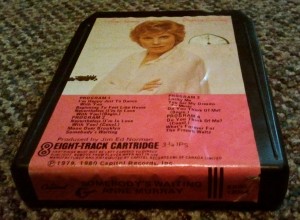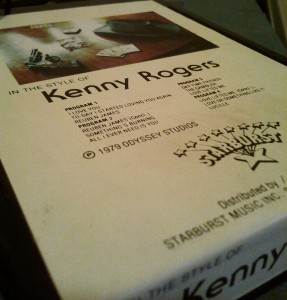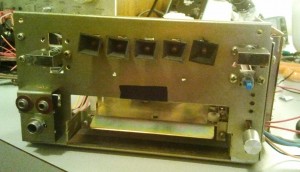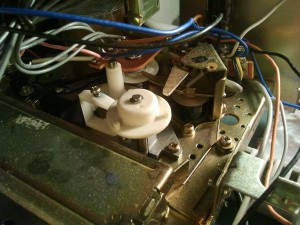A Half-Hearted Tribute To A Bad Idea Poorly Executed
March 15, 2013
I have long been meaning to work on some 8-track related projects. At long last intention grew to overpower inertia and I went looking for some raw materials. I was met with some surprises.
First, in the hiatus since I last went looking for old gear, many of my usual haunts have ceased to exist: the thrift store at 4th and McDonald has moved and gone upscale; the furniture store run by an incurable hoarder up at Main and 34th was liquidated by someone who wanted to run an actual business; and most lamentably, the free-for-all as-is section in the basement of the Sally Ann on 12th has been cleaned up and turned into pressboard furniture showroom. This left me feeling old. I fondly remember arriving at that Sally Ann just as a shipment of new junk was dumped into the troughs and it was a frenzy to be experienced. Unsaleable things that would’ve earned you a look of disapproval at the transfer station would show up in that basement for a dollar a pound — think Big Mouth Billy Bass at the nadir of his popularity; coffee makers with cracked decanters; mismatched department store speakers with torn fabric and wires cropped too short.
And of course the 8-track player, something I assumed would always be lurking in the corner, as omnipresent and unsaleable as macrame.
I began collecting old stereos as a pre-teen, trawling through the back aisles of Value Village in Coquitlam. I wanted one with everything — cassette, record player, AM/FM/short wave, 8-track, reel-to-reel, and whole banks of auxiliary inputs. In the process I populated my basement with a lot of equipment, mostly of abysmally low quality, fashioned from pressboard and plastic and little else. Most of them looked like this.

The brand name on this one is Channel Master, but it hardly matters. It could be Lloyd, or Viking, or Sears, Emerson, Magnasonic, or a dozen others, mostly made in Taiwan of the same low quality parts and often branded for whatever department store was importing them at the moment. These responded to the home stereo craze by delivering the poorest quality equipment that they could manufacture without entirely abandoning the pretense. (Channel Master, incidentally, lives on. They haven’t even changed their logo.)
The 8 track cartridge is the poster child for the era. The cassette tape was invented back in 1963 but numerous factors made it slow to achieve much market share. Meanwhile there were others trying to market a music format that would be compact and durable enough for automotive use — while there were automotive record players, they were obviously at a disadvantage — and into that environment, with inexplicable success, came the 8-track player. It was bulky, unpleasant and famously unreliable but gained the support of enough companies and consumers that it enjoyed widespread popularity from the late 1960s to the early 1980s in North America and the UK. (I’ve seen 8-track cartridges as far afield as Paraguay, in a thrift store which was also selling an oil painting of Adolf Hitler. It was The Beatles’ White Album.) By then the compact cassette had definitively shown its superiority and caused the 8-track to disappear in ignomy, not through the cassette’s own elegance or perfection so much as by failing to be as awful as the 8-track.
It was a design doomed to fail. It was much bigger than a cassette but was limited to only 45 minutes or so of music, stored on a continuous loop of tape wound on a spool inside the plastic case. The tape was hauled awkwardly out from the middle of the spool and wound back onto the outside, causing all manner of physical complications that boiled down to an unreliable format that by design could never rewind. Its most famous quirk — which gave it its name — is that it split an album into 4 “programs”, which were read off different stripes on the tape. 4 programs, each in stereo, makes 8 tracks. Great, if you don’t mind the chunk-chunk sound and break in the music as the tape head physically jumps to the vague vicinity of the next program every 12 minutes, triggered by a lump of tin foil attached to the tape crossing a couple of contacts in its path.
This is really stone-age technology and its sheer American blockheadedness is only clear piece of evidence I’ve ever found supporting the faked moon landing hypothesis. Could a nation that popularized this kind of technology possibly have been to the moon and back?
8-tracks and associated hardware consistently came up to the knees in every respectable thrift store I’ve ever known so it was with some surprise that I discovered that they’re becoming tougher to get. People actually expect money for them on EBay, and worse still, people are actually bidding for them. Locally, the selection is poorer and the prices are ridiculous — though I note that the guy asking $50 for a Ravi Shankar 8-track has just dropped his price to $40.
Long story short, after some sleuthing around Craigslist and Facebook I’ve come into possession of two stereos and a handful of cartridges without spending much. I’ll be working on a few projects but wanted to start with a general pillorying of the format and some photos of the specific units I got.
I have Leroy to thank for the tapes. He made me promise I’d never give them back, for obvious reasons.

To get you in the spirit of the 8-track era, here is Anne Murray giving you her bedroom eyes.

If you thought you were buying a Kenny Rogers cartridge, you’d be wrong — note the “In The Spirit Of” above his name. It doesn’t even say who’s performing and I haven’t mustered the courage to listen to it yet.

Here’s the business end of the Kenny Rogers knock-off. The capstan roller is visible on the left; there’s another roller inside the player that pinches the tape against the capstan, and as it turns, pulls tape from the middle of the spool. The resulting turning of the spool draws the tape back in the other side and winds it on. (Or that’s how it’s supposed to work, anyway.)
On the player side, both units are from all-in-one stereos. The first is pictured at the start of the post; the second is a Lloyd’s unit that came shelled from its chassis and only partially working:

Internally, these stereos are modular; record players can be unplugged and swapped easily, and though tape units and tuners are interconnected with wires soldered into place, they are built of separate components and circuit boards that are designed to be interchangeable. The Lloyd’s stereo contains an 8-track unit apparently made by Goldstar.
The Lloyd’s unit shows how laughably stone-aged this technology was:

From above:

Below is a close-up of the track switching mechanism. A small solenoid pulls a metal arm into the path of one of the cogs on a plastic wheel attached to the drive motor; when the arm is pulled along it causes the head to switch to the next program. In this way a small, cheap solenoid can get some help from the drive motor to do the lifting.

I pulled the tape head to try to figure it out, with unfortunately limited success: for no reason that’s clear to me, it has 7 pins plus a chassis ground. I’d expect two sets of coils, two for reading and two for recording, but how and why they’re wired in this configuration is not apparent.

The two strips on the front correspond to the left and right channels of whatever program the head is aligned to interact with.
I can’t say the Channel Master unit is markedly better but it does have more charm. It came to me with a drive belt that had decayed to the consistency of chewing gum. Easily replaced:

Here is the top view of the unit. Neither of these model numbers turn up any hits with Google; I’m startled when this happens but it seems to be consistently true of the 8-track era.

Below, looking at the control and amplifier board for the 8-track unit.

Below, looking at the tuner board; also where the 8-track and phonograph audio enters the switching area.

Below, another shot of the 8 track unit.

Below, a close-up of the track switching hardware and head.

Below, a close-up of the head (background) and the pins that detect when the foil strip marking the “end” of the tape passes through, triggering a track change.

Perhaps the biggest surprise was how scarce information on the 8-track is online. Beyond the Wikipedia page and 8 Track Heaven, there is remarkably little. Nerd culture delights in preserving oddities but somehow this one is not welcome.
Perhaps we’re ashamed. Perhaps we ought to be.
Categorized as: Uncategorized
I can’t find proof of this online, but I remember a second kind of 8-track cartridge that lacked a spool entirely: tape was just packed into the middle of it in the hopes that it wouldn’t get tangled. It always got tangled. If anyone can find details about these kinds of cartridges, please let me know.
I just got Rob Ford-rolled…
Seriously, though, after growing up with cassette tapes, I’m surprised to see how complex the older system was.
Rob Ford-rolled? That’s how Toronto feels 😉
It seems like the designers of the 8-track were too fixated on the idea of a continuous loop, and not for any really compelling reason. In order to make it work they had to kludge like mad, and to make it affordable they cheaped out, and in retrospect it’s just amazing the whole thing ever left the ground.
It’s not the only also-ran in the portable media market; maybe I’ll write up a survey of the others I know about, though admittedly none seem quite so iconic.
And if you really want to know shame, look up Compucolor, a very early 8080-based colour computer/terminal that, under other corporate names lived on just into this century. I bought a dual tape drive built for this machine surplus from United Products in Seattle circa 1984. This was the Compucolour’s infamous 8-track data cartridge “mass storage” system, of which I’ve heard the company sold quantities well into the two digits — and had nearly as many returns. They dumped floppy tape for mini floppy disks. (Then they presumably pretended they had never really intended to make a personal computer at all, just terminals.)
Through most of 1985 I kept threatening a CP/M head mate of mine that I was going to hack a BDOS driver for the beast just to see him look ill. I managed to read and write data to it at about 2400 bps, though it was supposedly capable of double that.
I wish I still had that piece of junk, if only to remind me to be more humble.
Ooh, excellent spotting! I wasn’t aware of the Compucolor but here it is. I did some research when originally writing this post to see if there were any computers that stored data on 8-tracks but obviously I didn’t search hard enough. Data on a medium you can’t reverse must’ve been *incredibly* cumbersome.
The only other example of data storage on 8-track that I could find was this Youtube video showing a cartridge that was apparently used to log locomotive data.
I had an 8-track player in college (late 90s). i actually bought a radio similar to the one in the picture to use as an amplifier so I could listen to MP3s from the computer with something better than typical computer speakers. Internally I disconnected the turntable and used that as an aux-in. If you think the quality of those old devices was bad consider that the first 10 years or so of downloadable music was mostly listened to on crappy little computer speakers! That crappy old radio as an amplifier sounded GREAT!
Anyway, I eventually picked up some 8-tracks to play on it from the local thrift shop. It wasn’t out of nostalgia or anything like that as 8-tracks are mostly before my time anyway. Mainly it was curiosity. It really did sound like crap. But… It sounded like the problem was that it was playing too slowly. Since this was already an over 20 y/o player and not a high end one either I didn’t really blame the format. I just figure that something was out of adjustment causing the motor to turn slow. Actually, the just slightly slow playback just made it more ‘twangy’ which was the perfect response to the guy across the hall blasting his rap. 🙂
So, anyway, why really hate 8-track so much? At least, why hate it for what it was considering it was pre-digital and pre-cheap affordable lasers?
>>”It was bulky, unpleasant and famously unreliable ”
“Bulky” – I don’t get the constant push for miniturization. Why does everything we own have to fit in our back pockets? I rant a lot about how I think the obsession with razor thin phones is stupid.
“Unpleasant” – Well, I’m assuming that ‘back in the day’ when not using a 20+ y/o ‘thrift store special’ player they must have sounded better than what I experienced. If so, then I guess unpleasant is just a matter of opinion.
“famously unreliable” – I never heard that one before but you have more experience than I! Radio stations used cart machines well into the 00s in large part because they were reliable. Those were very similar to 8-tracks, just a basic modification on the design. Maybe it was the small change that made them more reliable? I don’t know.
“…Great, if you don’t mind the chunk-chunk sound and break in the music as the tape head physically jumps to the vague vicinity of the next program every 12 minutes…”
8-tracks may have been mostly before my time but I certainly did suffer through the casette tape years. What really sucked about those was having to fast-forward or rewind for AGES to get to the particular song you wanted to hear. There were a few players that would auto-detect the gaps between songs and so had more convenient ‘skip’ buttons but those were rare and EXPENSIVE. Splitting a tape into 4 pieces that one could easily switch between with a press of a button… that would have been AWESOME. Given that there was no rewind I suppose the worst case would be that I want to re-play the song I just heard. So… I would have to fastforward around once. Given the tape is split in quarters that means I have to fastforward through 1/4 of it’s playback time. With casette having both fast forward and rewind but all one pair of tracks I might have to go through half of a side! Well, ok, I guess that is still 1/4 of the playback. Hmmm… Well.. 8-track gives one 4 points in the playback they can reach at any given moment without any fastforward or rewind at all. Casettes with their flipability give one two. That’s still an advantage for seeking. Why cry over an occasional thump thump when you gain convenience?
“…but was limited to 45 minutes of music…”
Yeah, that’s a clear disadvantage. But.. considering that for about the next 20 years after 8-tracks went out of style people were frequently spending $30+ (and that’s in 1990’s dollars) on CDs which often held less music even than that… doesn’t seem so unreasonable.
‘…can’t rewind…’
Yeah, that sucks.
‘..It seems like the designers of the 8-track were too fixated on the idea of a continuous loop’
Sounds like a great feature to me! Autoreverse was a pretty common feature in car cassette players but kind of rare in any other format. Having to stop what you were doing and flip the tape did kind of suck.
What’s my point?
I’m not convinced 8-tracks deserve this much bashing. I think I might have much preferred them over the casettes I grew up with. Don’t get me wrong though, I don’t want a comeback. I’ll keep my modern music files on flash media, thanks.
I applaud your defense of the 8-track; deep down I actually love it. But only for the same reasons I loved my first car or girlfriend: I hadn’t developed standards yet.
I grew up on these POS 8-track tapes: BJ Thomas, Bobby Darin, Roy Clark…My Dad got the stereo with bowling coupons (ooh, a red pin rack!!!) and Blue Chip Stamps from the market. What a F’n scam, this stereo wasn’t worth the hundreds of dollars spent getting these pennies on the dollar coupons. The Sound was terrible, no bass and no treble, just a constant tape hiss that was barely under the music volume. I remember seeing a 4″ hole where the speaker was behind the knit cloth in the 12X18 speaker box. So We are suffering through BJ’s “Rain Drops keep fallin on my head” and the song fades out..TG its finally over, only to hear that clunk, and then the song fades in again and keeps playing! Lord, just kill me now…..I absolutely love cassettes though..? I can handle the very soft hiss (or none at all with Dolby S) and I enjoy the mechanics of a brushed AL face deck with about 15 knobs, LED’s, meters and switches on the front all dancing in time with the music. FFWD, REW, its all good! CD’s are perfectly boring, sterile..you can’t even see them spinning! I’m stuck in the height of the monster receiver wars, 1978. What a great time for Home audio: 175WPC, analog meters and BIG tuner knobs…micro chip..What is that? These were packed with 30 lbs of transisitors, resistors, and 5 lb transformers….and WOOD!
I used to collect thift store/garage sale stereos, and was imprinted early with the early ’80s laminate/shitty turntable/top-load cassette/8-track/AM/FM aesthetic, in spite of its status as technical nadir. A good friend lusted after the Yorx M2680 since his young adulthood and recently bought one on Ebay, mostly for the cost of shipping; it’s indefensible but he’s very happy with it.
I think there may be a high point in quality sometime in the early 2000s, after e.g. optical inputs became established but before overcomputerization really set in. I have a Harman/Kardon unit from that era that’s my daily driver, and it has a nice heft to it. It feeds some great ’80s drivers that I found in a back alley — best speakers I’ve owned.